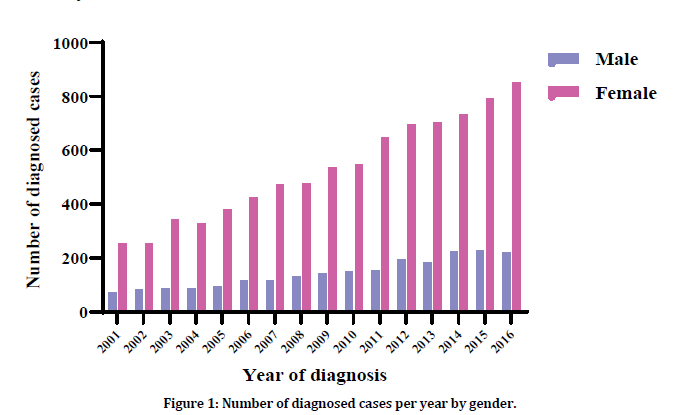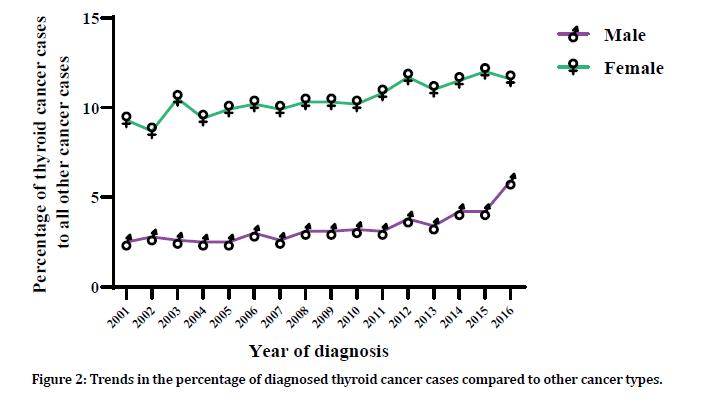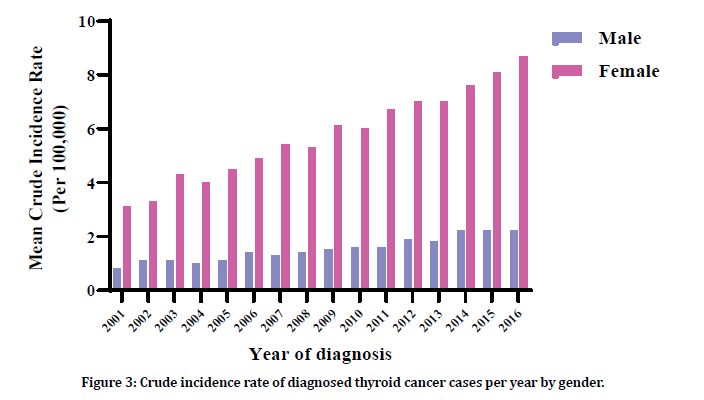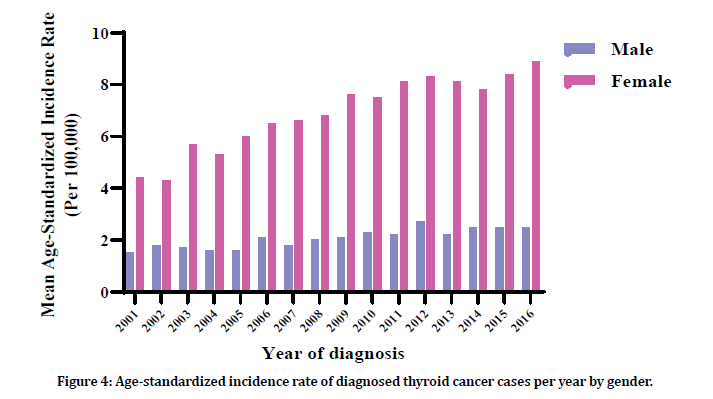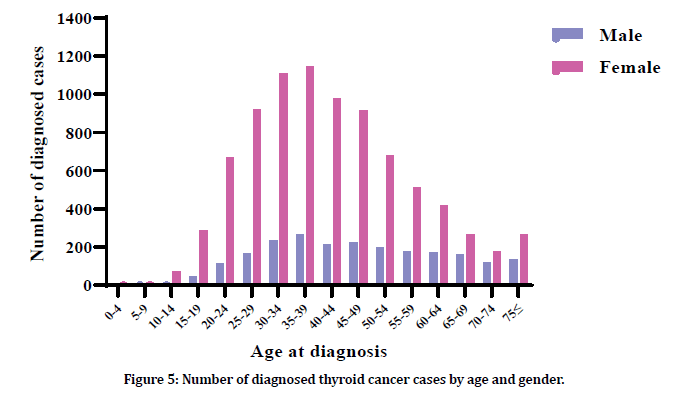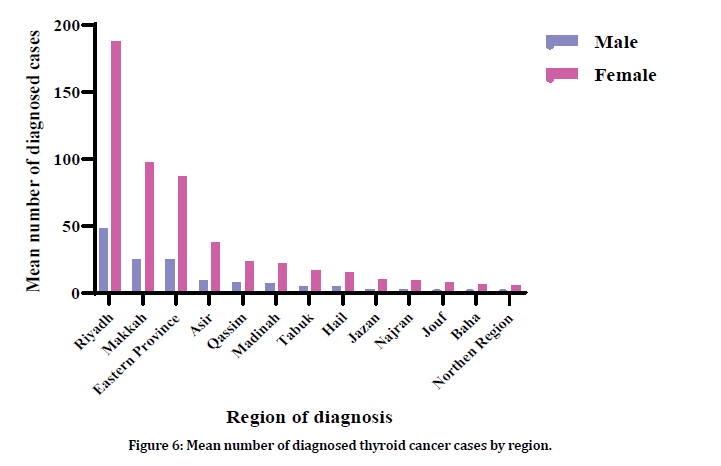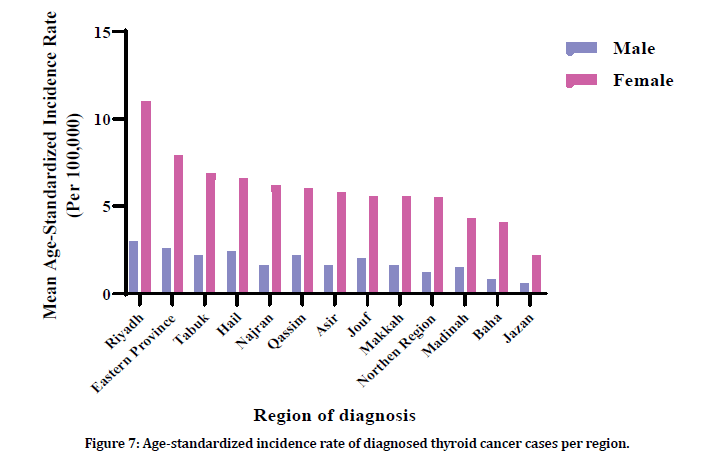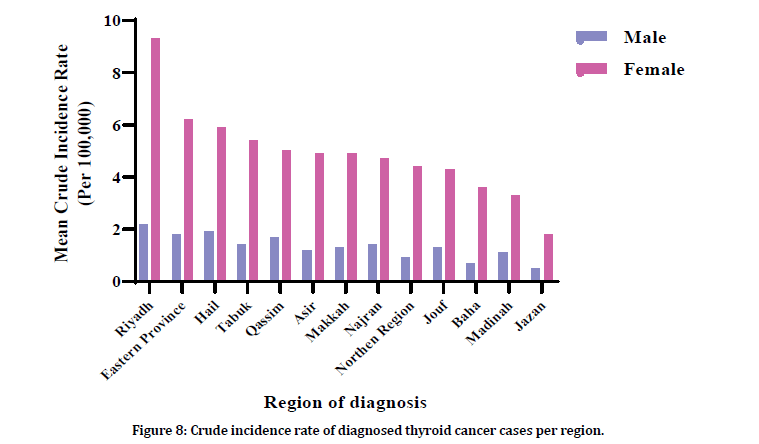Research - (2022) Volume 10, Issue 3
The Incidence Rate of Thyroid Cancer in Saudi Arabia from 2001 to 2016
*Correspondence: Basim Othman, Department of Public Health, Faculty of Applied Medical Sciences, Albaha University, Albaha 65779, Saudi Arabia, Email:
Abstract
Introduction: Thyroid cancer is one of the cancer diseases that have noticeably increased over the last decade, and in Saudi Arabia, it ranks as the second most common cancer among females. Aims: This study concerns an evaluation of the incidence trends of thyroid cancer among the Saudi population between 2001 and 2016 using the latest Saudi Cancer Registry (SCR) reports. Material and Methods: The analysis of this study included a total of 10,717 thyroid cancer cases (8,442 females and 2275 males) recorded in the files of the SCR. Results and Discussion: The incidence rate of thyroid cancer from 2001 to 2016 noticeably increased. The most common age group affected by thyroid cancer in both genders was 35–39 years. Between 2001 and 2016, Najran recorded the highest differences in rates of thyroid cancer compared to other Saudi regions. Meanwhile, Northern region clearly recorded a decrease in the rate of female thyroid cancer. Conclusion: Thyroid cancer is the second most common cancer among females in Saudi Arabia, with cases in both genders peaking from 35 to 39 years old. The significant reasons for this upward trend are still unknown. Further epidemiological and clinical research must be conducted to clarify and justify the causes of variations in the prevalence of thyroid cancer between provinces in Saudi Arabia.
Keywords
Thyroid cancer epidemiology, Thyroid cancer, Saudi cancer registry, Saudi Arabia
Introduction
Cancer is one of the major public health problems that threaten the health of citizens worldwide. It is considered to be among the top two leading causes of mortality before the age of 70 years in developed countries and among the top four in developing ones.
The International Agency for Research on Cancer (IARC) estimated that around 19.3 million new cancer cases were diagnosed in 2920, resulting in 9.9 million cancer deaths [1].
Thyroid cancer is one of the cancer diseases that have noticeably increased over the last decade [2]. Although thyroid cancer represents only about 1% of all malignancies, it is the most common type of malignancy (~90%) in the endocrine system and is one of the rare cancer diseases that affects women more than men [3]. The American Cancer Society estimates that about 44,280 new thyroid cancer cases were diagnosed in the United States in 2021, with about 2,200 deaths occurring that same year [4].
In 2016, the Saudi Cancer Registry (SCR) reported that thyroid cancer was the second most common cancer among the female population in Saudi Arabia and the ninth in the male population. The age-standardized incidence rate (ASIR) for thyroid cancer was 8.9 per 100,000 females in 2016, compared to 2.5 per 100,000 males [5].
The incidence rate of thyroid cancer in Saudi Arabia has not been discussed in many papers in the last few years, except in three scientific research studies. The first paper, published in 2013, used a hospital tumor registry program to evaluate retrospective data from 2000 to 2010 [6]. The second paper, published in 2015, analyzed the data in terms of female thyroid cancer incidence in Saudi Arabia from 2001 to 2008 using the SCR [7]. The third study, conducted in 2017, described the incidence of thyroid cancer in the Saudi population from 2001 to 2013 using data from the SCR [8].
Given the lack of up-to-date publications regarding the incidence of thyroid cancer in Saudi Arabia, there is a need to update the data about the incidence of thyroid cancer trends in the country. Thus, this study aims to evaluate the incidence rate of thyroid cancer among the Saudi population between 2001 and 2016 by using reports from the SCR.
Materials and Methods
Data
A retrospective descriptive epidemiological study of thyroid cancer cases diagnosed in the Saudi population between January 2001 and December 2016 was conducted. The analysis of this study included data for males and females. Therefore, this research concentrated on describing the epidemiological pattern of thyroid cancer in Saudi Arabia. The data were provided by the SCR, which was established in 1994 by the Ministry of Health in Saudi Arabia as a population-based registry. Thus, no ethical approval was required for this study.
Since 2001, the SCR has been providing reports on the pattern of thyroid cancers in Saudi Arabia, with the main objective of defining the incidence of the disease among the Saudi population. There are 16 comprehensive reports for the 13 administrative regions of Saudi Arabia from 2001 to 2016 that discuss the number of diagnosed cases, crude incidence rate (CIR), and ASIR broken down by the provinces of Saudi Arabia. This study was carried out to provide the descriptive epidemiology of thyroid cancer in Saudi Arabia through gathering data from the SCR.
Data analysis
For statistical analysis, version 9 of GraphPad Prism software was used. The descriptive epidemiological analysis of data was carried out by calculating the mean percentages of thyroid cancer cases and the CIR and ASIR adjusted by age group, gender, region, and year of diagnosis. The CIR and ASIR per 100,000 were calculated by the SCR.
Results
Numbers and percentages
A total of 10,717 thyroid cancer cases (8,442 females and 2,275 males) were recorded in the SCR reports from January 2001 to December 2016. In 2001, 325 thyroid cancer cases were reported (254 females and 71 males) (Figure 1). The percentages of diagnosed thyroid cancer cases for females and males in that year were 9.3% and 2.5%, respectively, compared to all other cancer types (Figure 2). The number of thyroid cancer cases rose gradually from 2001 until 2016, when the number of thyroid cancer cases peaked with 1076 cases (854 females and 222 males) (Figure 1). Furthermore, in 2016, the proportions of thyroid cancer cases out of all cancer types were 11.6% for females and 5.9% for males (Figure 2).
Figure 1: Number of diagnosed cases per year by gender.
Figure 2: Trends in the percentage of diagnosed thyroid cancer cases compared to other cancer types.
Crude incidence rate
The CIR in male thyroid cancer cases fluctuated between 0.8 and 2.2 in the period from 2011 to 2016. The peak CIR value of diagnosed thyroid cancers in the males showed in 2016 (Figure 3). The CIR in female cases also fluctuated from 2001 to 2016 between 3.1 and 8.7 (Figure 3). Merging the graphs of both genders illustrated a rising trend from 2.0 in 2001 to 5.6 in 2016 (Figure 3).
Figure 3: Crude incidence rate of diagnosed thyroid cancer cases per year by gender.
Age-standardized incidence rate
Between 2001 and 2016, the ASIR of male thyroid cancer cases fluctuated between 1.5 and 2.5, with the peak ASIR reaching 2.7 in 2012 (Figure 4). Meanwhile, the ASIR of female thyroid cancer cases in 2016 was almost double that in 2001. Thus, the trend of overall ASIR for both genders increased from 3.0 in 2001 to 5.7 in 2016 (Figure 4).
Figure 4: Age-standardized incidence rate of diagnosed thyroid cancer cases per year by gender.
Age groups
The SCR reports calculated the distribution of thyroid cancer cases by age group from 2001 to 2016. The groups were classified according to the age ranges of 0–4, 5–9, 10–14, 15–19, 20– 24, 25–29, 30–34, 35–39, 40–44, 45–49, 50–54, 55–59, 60–64, 65–69, 70–74, and older than 75 years. In terms of the numbers and percentages of thyroid cancer cases from 2001 to 2016, the least affected age group for both males and females was 0–4 years, with 0.04% and 0.05%, respectively (Figure 5).
Figure 5:Number of diagnosed thyroid cancer cases by age and gender.
In male diagnosed thyroid cancer cases, the highest number of patients was in the age group 35–39 years (267 cases, 12%), followed by those in the age group 30–34 years (236 cases, 10.5%) and then 45–49 years (222 cases, 10%) (Figure 5). However, in female cases, the highest number of cases was in the age group 35–39 years (1,144 cases, 13.5%), followed by those in the age group 30–34 years (1,108 cases, 13%) and then 40–44 years (980 cases, 12%) (Figure 5).
Regionally
The mean data of the ASIR and CIR of diagnosed thyroid cancer cases for the period between 2001 and 2016 were calculated by the SCR published reports. Therefore, the pattern of thyroid cancer among the Saudi population has been investigated using these data. The highest number of thyroid cancer cases from 2001 to 2016 was in Riyadh region, with an average of 117.5 per year (Figure 6). The second region with the highest number of cases was Makkah, with an average of 61.3 per year, followed by Eastern Province with an average of 56 per year (Figure 6). On the other hand, the regions with the lowest reported cases of thyroid cancer were Jouf, Baha, and Northern, with average cases of 5, 4, and 3.5 per year, respectively.
Figure 6:Mean number of diagnosed thyroid cancer cases by region.
ASIR data
According to the ASIR data, there was a variation in the mean ASIR of thyroid cancer cases in both males and females through regions. In males, Riyadh had the highest ASIR compared to all other regions with an average of 3, followed by Eastern Province with a mean of 2.6 and Hail region at 2.4 (Figure 7). However, Northern, Baha, and Jazan regions recorded the lowest average ASIR at 1.2, 0.8, and 0.6, respectively (Figure 7).
Figure 7:Age-standardized incidence rate of diagnosed thyroid cancer cases per region.
In females, the first three regions with the highest average ASIR were Riyadh at 11, Eastern at 8, and Tabuk at 7 (Figure 7). By contrast, the last three provinces with the lowest average ASIR were Madinah, Baha, and Jazan at 4.3, 4.1, and 2.2, respectively (Figure 7).
CIR data
No big differences were found in the mean CIR of male thyroid cancer cases between regions. The mean CIR ranged between 0.5 in Jazan and 2.2 in Riyadh (Figure 8).
Figure 8:Crude incidence rate of diagnosed thyroid cancer cases per region.
The female data indicated that Riyadh was at the top of the list of CIR with an average of 9.3 (Figure 8). The mean value of the CIR of other provinces ranged between 6.2 in the Eastern Province and 3.3 in Madinah. Jazan was at the end of the list with an average CIR of 1.8 (Figure 8).
Differences in CIR and ASIR
The differences in CIR and ASIR for the period between 2001 and 2016 were calculated according to the data from published SCR reports. Furthermore, the pattern of thyroid cancer in the Saudi population in different regions was investigated (Tables 1 and Table 2). Najran region had the greatest change in the rates of thyroid cancer per 100,000 women (10.3%, 7.4 CIR, and 8.7 ASIR) compared to all other regions, followed by Hail region with 9.1%, 7 CIR, and 7.9 ASIR (Table 1). However, Northern region recorded an obvious decrease in the percentage of female thyroid cancer cases. The rate of change in these cases was -8.2%, and the CIR and ASIR were -0.6 and -1.2, respectively (Table 1).
| Regions | % of thyroid cancer cases | CIR per 100,000 women | ASIR per 100,000 women | ||||||
|---|---|---|---|---|---|---|---|---|---|
| 2016 | 2001 | Diff. | 2016 | 2001 | Diff. | 2016 | 2001 | Diff. | |
| Asir | 12.9 | 14 | -1.1 | 7.7 | 4.3 | 3.4 | 7.4 | 3.5 | 3.9 |
| Baha | 6.2 | 10 | -3.8 | 2.6 | 1.9 | 0.7 | 2.2 | 1.7 | 0.5 |
| Jazan | 11.2 | 2.5 | 8.7* | 3.9 | 1.5 | 2.4 | 4.1 | 0.9 | 3.2 |
| Madinah | 7.3 | 5.8 | 1.5 | 3.6 | 1.8 | 1.8 | 3.7 | 3.5 | 0.2 |
| Hail | 15.9 | 6.8 | 9.1* | 9 | 2 | 7.0* | 9.6 | 1.7 | 7.9* |
| Qassim | 7.3 | 9.5 | -2.2 | 4.9 | 2.5 | 2.4 | 5.5 | 3.1 | 2.4 |
| Najran | 14.8 | 4.5 | 10.3* | 8.4 | 1 | 7.4* | 9.9 | 1.2 | 8.7* |
| Jouf | 12.9 | 4.5 | 8.4* | 8.7 | 0.9 | 7.8* | 9.8 | 0.7 | 9.1* |
| Tabuk | 20.5 | 23.8 | -3.3 | 11.8 | 9 | 2.8 | 12.9 | 7.6 | 5.3 |
| Northern Region | 13.8 | 22 | -8.2** | 5.6 | 5 | 0.6 | 5.7 | 6.9 | -1.2** |
| Riyadh | 16.3 | 12.2 | 4.1 | 15.4 | 9.9 | 5.5 | 16.6 | 6.2 | 10.4* |
| Makkah | 8.1 | 4.8 | 3.3 | 6.2 | 2.4 | 3.8 | 5.9 | 1.5 | 4.4 |
| Eastern Province | 8.8 | 8.3 | 0.5 | 8.6 | 3.3 | 5.3 | 9.6 | 5.5 | 4.1 |
| *Noticeable increase compared to the value of other regions. **Noticeable decrease compared to the value of other regions. | |||||||||
| CIR, crude incidence rate; ASIR, age-standardized incidence rate. | |||||||||
Table 1: Differences in the percentage, CIR, and ASIR of thyroid cancer cases among women in different regions of Saudi Arabia (2001-2016).
In terms of the rate of change in male thyroid cancer cases, Najran was the only region that had a noticeable change in percentage of cases compared to other regions (8.5%, 2.3 CIR and 4.2 ASIR) (Table 2).
| Regions | % of thyroid cancer cases | CIR per 100,000 men | ASIR per 100,000 men | ||||||
|---|---|---|---|---|---|---|---|---|---|
| 2016 | 2001 | Diff. | 2016 | 2001 | Diff. | 2016 | 2001 | Diff. | |
| Asir | 1.6 | 1 | 0.6 | 0.9 | 0.5 | 0.4 | 1 | 0.3 | 0.7 |
| Baha | 2.4 | 0 | 2.4 | 1.1 | 0 | 1.1 | 1 | 0 | 1 |
| Jazan | 2 | 2.9 | -0.9 | 0.5 | ** | 0.5 | 0.5 | 0.8 | -0.3 |
| Madinah | 2.4 | 2.7 | -0.3 | 1 | 0.7 | 0.3 | 1.2 | 0.7 | 0.5 |
| Hail | 7.6 | 6.7 | 0.9 | 2.3 | 2.4 | -0.1 | 2.4 | 1.8 | 0.6 |
| Qassim | 5.8 | 1.1 | 4.7 | 2.6 | ** | 2.6 | 3.1 | 0.8 | 2.3 |
| Najran | 10.3 | 1.8 | 8.5* | 4.1 | 1.8 | 2.3 | 4.8 | 0.6 | 4.2 |
| Jouf | 4.3 | 2.8 | 1.5 | 2.1 | 0.9 | 1.2 | 2.3 | 0.7 | 1.6 |
| Tabuk | 5.2 | 1.2 | 4 | 2.2 | 0.5 | 1.7 | 2.5 | 0.4 | 2.1 |
| Northern Region | 3 | 0 | 3 | 1.4 | 0 | 1.4 | 1.4 | 0 | 1.4 |
| Riyadh | 5.1 | 2.6 | 2.5 | 3.4 | 2.5 | 0.9 | 4.4 | 1.4 | 3 |
| Makkah | 2.4 | 3 | -0.6 | 1.4 | 1.9 | -0.5 | 1.5 | 1 | 0.5 |
| Eastern Province | 4.2 | 2.1 | 2.1 | 2.9 | ** | 2.9 | 3.4 | 1.7 | 1.7 |
| *Noticeable increase compared to the value of other regions. **Data were missing in the Saudi Health Council (SHC) reports. | |||||||||
| CIR, crude incidence rate; ASIR, age-standardized incidence rate. | |||||||||
Table 2: Differences in the percentage, CIR, and ASIR of thyroid cancer cases among men in different regions of Saudi Arabia (2001-2016).
Discussion
The epidemiological study of thyroid cancer in populations helps to identify the patterns of this disease and minimize its incidence. Accordingly, this study was designed to evaluate the incidence rate of thyroid cancer among the Saudi population between 2001 and 2016 by using reports from the SCR. It is obvious that the incidence rate of thyroid cancer cases in the population of Saudi Arabia roughly tripled between 2001 and 2016. There are several possible causes linked to the above outcomes. The first reason for the increasing number of diagnosed thyroid cancer cases is the rise in the number of healthcare provider centers that are equipped with advanced diagnostic techniques and imaging. In 2002, the Saudi Ministry of Health established the national health system to provide comprehensive and integrated healthcare to the population of Saudi Arabia. For this, the number of government hospitals increased from 189 in 2002 to 287 in 2020 [9].
Another possible cause for the increase in thyroid cancer incidence is iodine deficiency. Several published studies have found a relationship between iodine deficiency and a rise in the number of diagnosed thyroid cancer cases [10- 12]. Although historical data on iodine deficiency in Saudi Arabia are lacking, several papers have shown that the Saudi population, particularly in the southern provinces, has an iodine deficit [12- 15].
Rapid urbanization and modernization could be another cause for the increasing cases of thyroid cancer in the last decade. Fast economic development is reflected in the changing lifestyles of the Saudi population. It is accompanied by the consumption of junk foods, unhealthy diets, sedentary lifestyles, and obesity [16], all of which are considered as risk factors for thyroid cancer [17-19].
Regarding the gender data, it is obvious that the incidence of thyroid cancer in females is four times higher than that in males. The ASIR of female thyroid cancer cases increased sharply at 15–19 years (beginning of the reproductive age) and peaked at the starting age of the premenopausal period (35–39 years). These outcomes are consistent with other studies of thyroid cancer that have focused on gender differences [20-22]. The peak rates of female thyroid cancer occurred in the pre-menopausal period, which suggests that female sex hormones have a role in increasing the incidence of thyroid cancer. A connection also exists between breast tumors and thyroid cancers. Several studies have illustrated that people with a history of breast cancer have a higher risk of developing thyroid cancer [23,24] and those with a history of thyroid cancer have an increased risk of developing breast cancer [24,25]. Consequently, it has been suggested that thyroid cancer and breast cancer, which is a malignancy that responds to estrogen hormone, might share some common causing factors.
There was an obvious difference in the incidence rate of thyroid cancer among Saudi females compared to the international rate. According to the most recent published report from the IARC in 2020, the fifth most common cancer among females around the world is thyroid cancer, with an ASIR of 10.1 [1]. However, in Saudi Arabia, thyroid cancer is the second most common cancer among females, with an ASIR of 8.9. This result indicates that an etiological local factor might play a role in this variation. Several studies have linked vitamin D deficiency with cancers [26- 28], specifically thyroid carcinoma [29]. Thus, vitamin D deficiency may play an important role as a local risk factor that leads to an increase in thyroid cancer incidence rate among Saudi females compared to the global ratio. A recent study about vitamin D deficiency in Saudi Arabia suggested that more Saudi women are suffering from vitamin D deficiency than men because of their lack of exposure to sunlight [30].
The current study observed the geographical distribution and changes in the CIRs and ASIRs of female thyroid cancer cases in different regions for the period 2001 to 2016. The data illustrated that the only Saudi region with a noticeable rise in the rate of female thyroid cancer was Najran. Meanwhile, Northern region recorded an obvious decrease in the rate of thyroid cancer among Saudi females. Although published studies that discuss the pattern of geographical distribution of thyroid cancer in the Saudi population are scant, the present study may generate a hypothesis about the potential risk factors for thyroid cancer in regions of Saudi Arabia.
Conclusion
Thyroid cancer is currently the second most common cancer among females in Saudi Arabia. The most common age group for both male and female thyroid cancer cases is 35–39 years. The incidence rate of thyroid cancer for both genders increased from 2001 to 2016. The main reasons for the upward trend of thyroid cancer in Saudi Arabia are still unknown. However, many etiological factors have been suggested for this increase. Further clinical and epidemiological studies need to be conducted to clarify the specific causes that lead to the increase in incidence rate of female thyroid cancer in different regions in 2016 compared to 2001.
Author Contributions
All authors made a significant contribution to the work reported, whether it be in the conception, study design, execution, acquisition of data, analysis, and interpretation or in all these areas. They all took part in drafting, revising, or critically reviewing the article; gave final approval of the version to be published; agreed on the journal to which the article has been submitted; and agreed to be accountable for all aspects of the work.
Funding
This research did not receive any specific grant from funding agencies in the public, commercial, or not-for-profit sector. The authors have no financial relationships relevant to this article to disclose.
Disclosure
The authors have no conflicts of interest to disclose.
References
- Sung H, Ferlay J, Siegel RL et al. Global cancer statistics 2020: GLOBOCAN estimates of incidence and mortality worldwide for 36 cancers in 185 countries. CA Cancer J Clin 2021; 71:209-249.
- Vergamini LB, Frazier AL, Abrantes FL, et al. Increase in the incidence of differentiated thyroid carcinoma in children, adolescents, and young adults: A population-based study. J Pediatr 2014; 164:1481-1485.
- Nagataki S, Nystrom E. Epidemiology and primary prevention of thyroid cancer. Thyroid 2002; 12:889-896.
- American Cancer Society. Cancer Statistics 2021 Report. J Nucl Med 2021; 62:12N.
- https://nhic.gov.sa/en/eServices/Documents/2016.pdf
- Hussain F, Iqbal S, Mehmood A, et al. Incidence of thyroid cancer in the Kingdom of Saudi Arabia, 2000-2010. Hematol Oncol Stem Cell Ther 2013; 6:58-64.
- Alghamdi IG, Hussain, II, Alghamdi MS, et al. The incidence rate of thyroid cancer among women in Saudi Arabia: An observational descriptive epidemiological analysis of data from Saudi Cancer Registry 2001-2008. J Immigr Minor Health 2015; 17:638-643.
- Alshehri B. Descriptive epidemiological analysis of thyroid cancer in the Saudi population (2001-2013). Asian Pac J Cancer Prev 2017; 18:1445-1451.
- https://www.moh.gov.sa/en/Ministry/Statistics/book/Pages/default.aspx
- Zimmermann MB, Galetti V. Iodine intake as a risk factor for thyroid cancer: A comprehensive review of animal and human studies. Thyroid Res 2015; 8:8.
- Kim HJ, Kim NK, Park HK, et al. Strong association of relatively low and extremely excessive iodine intakes with thyroid cancer in an iodine-replete area. Eur J Nutr 2017; 56:965-971.
- Al-Nuaim AR, Al-Mazrou Y, Kamel M, et al. Iodine deficiency in Saudi Arabia. Ann Saudi Med 1997; 17:293-297.
- Alsanosy RM, Gaffar AM, Khalafalla HE, et al. Current iodine nutrition status and progress toward elimination of iodine deficiency disorders in Jazan, Saudi Arabia. BMC Public Health 2012; 12:1006.
- Abbag FI, Abu-Eshy SA, Mahfouz AA, et al. Iodine-deficiency disorders in the Aseer region, south-western Saudi Arabia: 20 years after the national survey and universal salt iodization. Public Health Nutr 2015; 18:2523-2529.
- Al-Dakheel MH, Haridi HK, Al-Bashir BM, et al. Prevalence of iodine deficiency disorders among school children in Saudi Arabia: Results of a national iodine nutrition study. East Mediterr Health J 2016; 22:301-308.
- Contaldo F, Mazzarella G, Santarpia L, et al. Influence of urbanization on childhood obesity. Nutr Metab Cardiovasc Dis 2015; 25:615-616.
- Mijovic T, How J, Payne RJ. Obesity and thyroid cancer. Front Biosci 2011; 3:555-564.
- Marcello MA, Cunha LL, Batista FA, et al. Obesity and thyroid cancer. Endocr Relat Cancer 2014; 21:T255-271.
- Ma J, Huang M, Wang L, et al. Obesity and risk of thyroid cancer: Evidence from a meta-analysis of 21 observational studies. Med Sci Monit 2015; 21:283-291.
- Machens A, Hauptmann S, Dralle H. Disparities between male and female patients with thyroid cancers: Sex difference or gender divide? Clin Endocrinol 2006; 65:500-505.
- Rahbari R, Zhang L, Kebebew E. Thyroid cancer gender disparity. Future Oncol 2010; 6:1771-1779.
- Hsieh SH, Chen ST, Hsueh C, et a. Gender-specific variation in the prognosis of papillary thyroid cancer TNM stages II to IV. Int J Endocrinol 2012; 2012:379097.
- Ron E, Curtis R, Hoffman DA, et al. Multiple primary breast and thyroid cancer. Br J Cancer 1984; 49:87-92.
- Teppo L, Pukkala E, Saxen E. Multiple cancer--an epidemiologic exercise in Finland. J Natl Cancer Inst 1985; 75:207-217.
- Chen AY, Levy L, Goepfert H, et al. The development of breast carcinoma in women with thyroid carcinoma. Cancer 2001; 92:225-231.
- Garland CF, Garland FC, Gorham ED, et al. The role of vitamin D in cancer prevention. Am J Public Health 2006; 96:252-261.
- Holick MF. Resurrection of vitamin D deficiency and rickets. J Clin Invest 2006; 116:2062-2072.
- Holick MF. Vitamin D deficiency. N Engl J Med 2007; 357:266-281.
- Kim JR, Kim BH, Kim SM, et al. Low serum 25 hydroxyvitamin D is associated with poor clinicopathologic characteristics in female patients with papillary thyroid cancer. Thyroid 2014; 24:1618-1624.
- AlFaris NA, AlKehayez NM, AlMushawah FI, et al. Vitamin D deficiency and associated risk factors in women from Riyadh, Saudi Arabia. Sci Rep 2019; 9:20371.
Indexed at, Google Scholar, Cross Ref
Indexed at, Google Scholar, Cross Ref
Indexed at, Google Scholar, Cross Ref
Indexed at, Google Scholar, Cross Ref
Indexed at, Google Scholar, Cross Ref
Indexed at, Google Scholar, Cross Ref
Indexed at, Google Scholar, Cross Ref
Indexed at, Google Scholar, Cross Ref
Indexed at, Google Scholar, Cross Ref
Indexed at, Google Scholar, Cross Ref
Indexed at, Google Scholar, Cross Ref
Indexed at, Google Scholar, Cross Ref
Indexed at, Google Scholar, Cross Ref
Indexed at, Google Scholar, Cross Ref
Indexed at, Google Scholar, Cross Ref
Indexed at, Google Scholar, Cross Ref
Indexed at, Google Scholar, Cross Ref
Indexed at, Google Scholar, Cross Ref
Indexed at, Google Scholar, Cross Ref
Indexed at, Google Scholar, Cross Ref
Indexed at, Google Scholar, Cross Ref
Indexed at, Google Scholar, Cross Ref
Indexed at, Google Scholar, Cross Ref
Indexed at, Google Scholar, Cross Ref
Indexed at,Google Scholar, Cross Ref
Author Info
Department of Public Health, Faculty of Applied Medical Sciences, Albaha University, Albaha 65779, Saudi ArabiaCitation: Basim Othman, The Incidence Rate of Thyroid Cancer in Saudi Arabia from 2001 to 2016, J Res Med Dent Sci, 2022, 10 (3):56-64.
Received: 02-Mar-2022, Manuscript No. JRMDS-22-55954; , Pre QC No. JRMDS-22-55954 (PQ); Editor assigned: 04-Mar-2022, Pre QC No. JRMDS-22-55954 (PQ); Reviewed: 18-Mar-2022, QC No. JRMDS-22-55954; Revised: 23-Mar-2022, Manuscript No. JRMDS-22-55954 (R); Published: 30-Mar-2022

